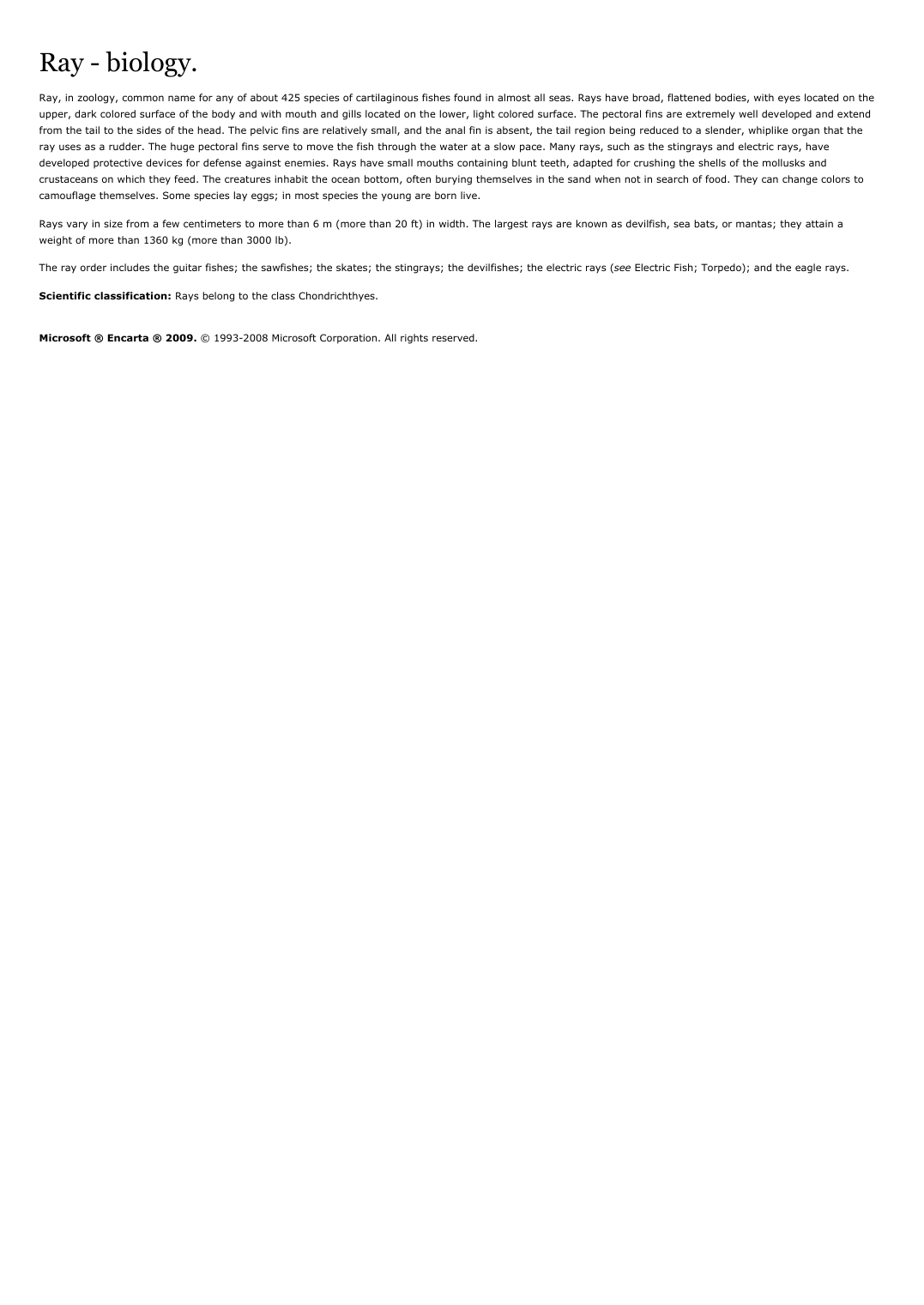Ray - biology.
Publié le 06/12/2021
Extrait du document
Ci-dessous un extrait traitant le sujet : Ray - biology.. Ce document contient 277 mots. Pour le télécharger en entier, envoyez-nous un de vos documents grâce à notre système d’échange gratuit de ressources numériques ou achetez-le pour la modique somme d’un euro symbolique. Cette aide totalement rédigée en format pdf sera utile aux lycéens ou étudiants ayant un devoir à réaliser ou une leçon à approfondir en : Echange
Ray - biology.
Ray, in zoology, common name for any of about 425 species of cartilaginous fishes found in almost all seas. Rays have broad, flattened bodies, with eyes located on the
upper, dark colored surface of the body and with mouth and gills located on the lower, light colored surface. The pectoral fins are extremely well developed and extend
from the tail to the sides of the head. The pelvic fins are relatively small, and the anal fin is absent, the tail region being reduced to a slender, whiplike organ that the
ray uses as a rudder. The huge pectoral fins serve to move the fish through the water at a slow pace. Many rays, such as the stingrays and electric rays, have
developed protective devices for defense against enemies. Rays have small mouths containing blunt teeth, adapted for crushing the shells of the mollusks and
crustaceans on which they feed. The creatures inhabit the ocean bottom, often burying themselves in the sand when not in search of food. They can change colors to
camouflage themselves. Some species lay eggs; in most species the young are born live.
Rays vary in size from a few centimeters to more than 6 m (more than 20 ft) in width. The largest rays are known as devilfish, sea bats, or mantas; they attain a
weight of more than 1360 kg (more than 3000 lb).
The ray order includes the guitar fishes; the sawfishes; the skates; the stingrays; the devilfishes; the electric rays (see Electric Fish; Torpedo); and the eagle rays.
Scientific classification: Rays belong to the class Chondrichthyes.
Microsoft ® Encarta ® 2009. © 1993-2008 Microsoft Corporation. All rights reserved.
Ray - biology.
Ray, in zoology, common name for any of about 425 species of cartilaginous fishes found in almost all seas. Rays have broad, flattened bodies, with eyes located on the
upper, dark colored surface of the body and with mouth and gills located on the lower, light colored surface. The pectoral fins are extremely well developed and extend
from the tail to the sides of the head. The pelvic fins are relatively small, and the anal fin is absent, the tail region being reduced to a slender, whiplike organ that the
ray uses as a rudder. The huge pectoral fins serve to move the fish through the water at a slow pace. Many rays, such as the stingrays and electric rays, have
developed protective devices for defense against enemies. Rays have small mouths containing blunt teeth, adapted for crushing the shells of the mollusks and
crustaceans on which they feed. The creatures inhabit the ocean bottom, often burying themselves in the sand when not in search of food. They can change colors to
camouflage themselves. Some species lay eggs; in most species the young are born live.
Rays vary in size from a few centimeters to more than 6 m (more than 20 ft) in width. The largest rays are known as devilfish, sea bats, or mantas; they attain a
weight of more than 1360 kg (more than 3000 lb).
The ray order includes the guitar fishes; the sawfishes; the skates; the stingrays; the devilfishes; the electric rays (see Electric Fish; Torpedo); and the eagle rays.
Scientific classification: Rays belong to the class Chondrichthyes.
Microsoft ® Encarta ® 2009. © 1993-2008 Microsoft Corporation. All rights reserved.
↓↓↓ APERÇU DU DOCUMENT ↓↓↓

































